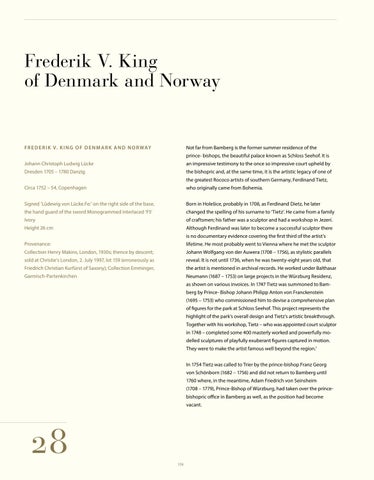Frederik V. King of Denmark and Norway
F R E D E R I K V. K I N G O F D E N M A R K A N D N O R WAY
Not far from Bamberg is the former summer residence of the prince- bishops, the beautiful palace known as Schloss Seehof. It is
Johann Christoph Ludwig Lücke
an impressive testimony to the once so impressive court upheld by
Dresden 1705 – 1780 Danzig
the bishopric and, at the same time, it is the artistic legacy of one of the greatest Rococo artists of southern Germany, Ferdinand Tietz,
Circa 1752 – 54, Copenhagen
who originally came from Bohemia.
Signed ‘Lŭdewig von Lücke.Fe:’ on the right side of the base,
Born in Holešice, probably in 1708, as Ferdinand Dietz, he later
the hand guard of the sword Monogrammed interlaced ‘F5’
changed the spelling of his surname to ‘Tietz’. He came from a family
Ivory
of craftsmen; his father was a sculptor and had a workshop in Jezerí.
Height 26 cm
Although Ferdinand was later to become a successful sculptor there is no documentary evidence covering the first third of the artist’s
Provenance:
lifetime. He most probably went to Vienna where he met the sculptor
Collection Henry Makins, London, 1930s; thence by descent;
Johann Wolfgang von der Auwera (1708 – 1756), as stylistic parallels
sold at Christie’s London, 2. July 1997, lot 159 (erroneously as
reveal. It is not until 1736, when he was twenty-eight years old, that
Friedrich Christian Kurfürst of Saxony); Collection Emminger,
the artist is mentioned in archival records. He worked under Balthasar
Garmisch-Partenkirchen
Neumann (1687 – 1753) on large projects in the Würzburg Residenz, as shown on various invoices. In 1747 Tietz was summoned to Bamberg by Prince- Bishop Johann Philipp Anton von Franckenstein (1695 – 1753) who commissioned him to devise a comprehensive plan of figures for the park at Schloss Seehof. This project represents the highlight of the park’s overall design and Tietz’s artistic breakthrough. Together with his workshop, Tietz – who was appointed court sculptor in 1748 – completed some 400 masterly worked and powerfully modelled sculptures of playfully exuberant figures captured in motion. They were to make the artist famous well beyond the region.1 In 1754 Tietz was called to Trier by the prince-bishop Franz Georg von Schönborn (1682 – 1756) and did not return to Bamberg until 1760 where, in the meantime, Adam Friedrich von Seinsheim (1708 – 1779), Prince-Bishop of Würzburg, had taken over the princebishopric office in Bamberg as well, as the position had become vacant.
28
174












